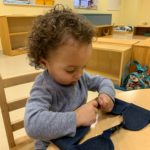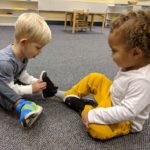Toilet Training

In almost all childcare settings, the age of three becomes a magical number for many children – moving to a new room, beginning a more academic-focused curriculum, and greater independence. Yet before all that can happen, a child must master potty training!
Why is this skill so important? It is the culmination of a series of developmental milestones that your child must use in synchronization. Challenges with learning to use the toilet often occur because one of the underlying skills has not been mastered, and we, as adults, want to rush the process. But much like crawling and walking, the isolation of each muscle movement must come together into fluid coordination for a child to be successful.
At The Glen, learning to use the toilet is a partnership between parents and their child’s teachers. It begins years in advance. Starting as soon as a baby can comfortably stand on their own for 5-10 minutes, Glen faculty begin changing their diapers standing up. This process facilitates independence as the child grows, allows for practice managing clothing, and moves to the toilet as the child gains interest and confidence. In addition, using specific rest-room facilities for changing a child sends the message that toileting activities occur in a particular location. So when it comes time to begin learning to use the toilet, the link for going to the bathroom is already established!
By observing the child’s interests and behaviors, parents and teachers can see indicators that a child is ready to learn to use the toilet and work together to encourage this interest. For example, in Birth to Three classrooms, Glen teachers are looking for a child who wakes up from their nap dry, is interested in the toileting process, and can manage their clothing independently: push down their pants and pull them back up. By around 2-2 ½ years or so, most children are physically capable of managing the toileting process, so when their attention and interest peak, it is time to start.
When ready, parents and teachers need time and patience to accomplish this milestone. It takes a commitment of time, staying home, controlling liquid intake, and consistently developing a toileting schedule (beginning, in underwear—not pull-ups—every 30 minutes).
“Accidents,” or soiling in the underwear, are to be expected and are no reason to get upset. Children are developing body awareness and language to recognize the physical feeling of toileting and the ability to verbalize it promptly. Instead of getting upset with the child or referring to the mishap as an “accident,” Glen faculty focus on helping children describe the feeling they experience (wet, cold, uncomfortable in their underwear) due to not using the toilet.
It is essential to partner with your child’s teacher when taking the plunge into underwear so that “accidents” do not occur for an extended period of time. Typically we do not see this at The Glen. However, when a child is rushed into underwear, soiling will continue to occur without reducing the frequency for a prolonged duration. Introducing toileting too soon can, potentially, derail the entire process.
Natural consequences are a focus of Montessori. For example, when a child spills a drink, they clean it up. Likewise, when a child does not make it to the toilet in time, they change their wet clothes into dry ones, put their soiled underwear and clothing into the laundry, and clean up anything left in the bathroom (all under the careful supervision of an adult of course!). While time-consuming, this activity helps the child connect the need for toileting and the consequences of not using the toilet.
Learning to use the toilet is one of the most significant accomplishments a toddler will achieve during these first three years! Like sitting up, learning to crawl, and learning to walk, learning to use the toilet is hard work and takes time. Patience and consistency are key!






